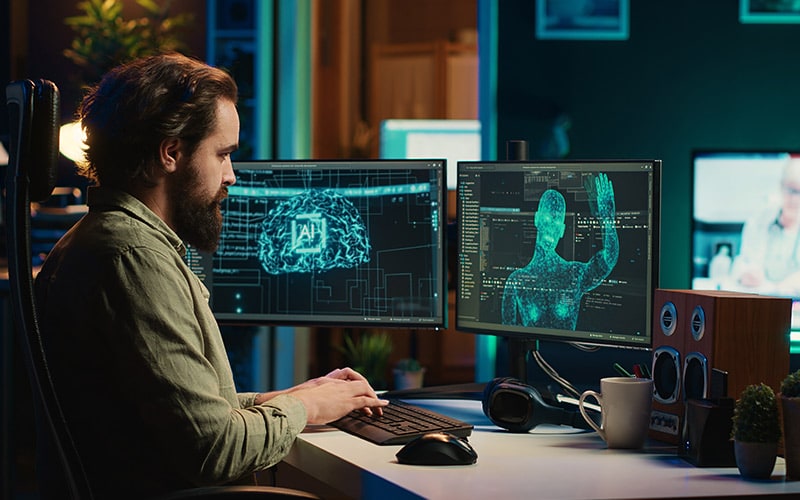- Infosys decided to reconfigure the company’s operating model and build an organization that was designed to evolve — a live enterprise. The aim was to create a new digital infrastructure built on open-source, cloud-based architecture that empowered employees through digital tools.
- This transformation was driven by Infosys’ information systems (IS), and other cross functional teams. The three layers of transformation were:
- Creating perceptive user experiences to simplify processes and shift to a more intuitive approach.
- Redesigning the underlying processes with Live process provided real time insights on process bottlenecks as business functions such as HR and finance adopted a hyperproductive model using extreme automation, chatbots, and self-service capabilities.
- Building a live enterprise with engineering, operations, and technology infrastructure redesigned to create a more agile IS team
- The InfyMe platform was built on the Live Enterprise model, using open source technology, which allows it to evolve and scale.
- The Infosys Knowledge Graph links information across the enterprise and fuels a digital brain that can make intelligent decisions based on insights. This enables the organization to respond to customers, employees, and the external environment in real time — just like a living organism.
Infosys is one of the industry leaders in next generation digital solutions. But a lesser known fact is that Infosys underwent a transformational journey of four years to create a digital platform which would be the core of the company. A platform that could interact seamlessly, learn continuously, and respond to it employees, clients, and partner ecosystems. Infosys transformed its employee experience, made itself a living and breathing enterprise and demonstrated remarkable agility in this unforeseen pandemic.
Before the journey started, Infosys had many tedious and time consuming internal operational processes consisting of over 100 system touch points. Functionalities on mobile devices were limited. The processes were not intelligent enough to help employees respond quickly and be more productive. If Infosys were to continue its growth trajectory, it would need to reimagine its enterprise processes and employee experience, and also increase the speed of innovation.
Infosys decided to reconfigure the company’s operating model and build an organization that was designed to evolve — a live enterprise. The aim was to create a new digital infrastructure built on open-source, cloud-based architecture that empowered employees through digital tools. Infosys leaders also wanted to build an agile work culture that fostered innovation at scale.
This transformation was driven by Infosys’ information systems (IS), and other cross functional teams. The three layers of transformation were:
- Creating perceptive user experiences — A new employee experience was created to simplify processes and shift to a more intuitive approach. More than 200 touch points for various activities were merged into a single intuitive interface: the InfyMe app. The digital tools allow employees to access information and services anytime, anyplace.
- Redesigning the underlying processes — Business functions such as HR and finance adopted a hyperproductive model using extreme automation, chatbots, and self-service capabilities. Live process provided real time insights on process bottlenecks. More than 250 robotic process automations and 35 plus chatbots reduced human effort and were able to answer initial support queries.
- Building a live enterprise — The engineering, operations, and technology infrastructure was redesigned to create a more agile IS team. This enabled them to rapidly transform user experience and support functions through incremental innovation.
The InfyMe platform was built on the Live Enterprise model, using open source technology, which allows it to evolve and scale. The Infosys Knowledge Graph links information across the enterprise and fuels a digital brain that can make intelligent decisions based on insights. This enables the organization to respond to customers, employees, and the external environment in real time — just like a living organism.
An example of how this platform helps in informed decision-making can be seen in the allocation of staff for projects. Typically, a manager requests an employee with specific skills, and then the talent team searches for that person. This can be time consuming. Now managers use the InfyMe app to search the organization and find individuals with specific skills. It also shows adjacent skills in terms of percentages. If managers do not find anyone who has the exact skillset needed, they can identify employees who are the closest and upskill them. This has reduced the time needed to find the right talent by 50%.
The effectiveness of the live enterprise model was demonstrated when the pandemic struck last year. More than 99% of the employees, spread across 43 countries, were able to quickly transition into work-from-home mode within two weeks. This resilient model received business continuity awards for 2020 from The Economic Times Digital Warrior and CIO100.1
Creating perceptive user experiences
Previously, Infosys services were created in silos that led to a disjointed experience. Erstwhile InfosysIT app had an application-centric view where employees had to know the exact navigation path to reach even simple functions. With the InfyMe app, this underlying approach shifted from application-centric to action centric, so employees could access the desired function intuitively. All this could be done without having to connect to the company’s network. The unified search platform, powered by Infosys’ NIA artificial intelligence (AI) and natural language understanding, enabled employees to more easily find structured and unstructured content, including white papers, case studies, blogs, proposals, the Infosys glossary, and learning and certification content.
Today, this model enables employees to do as much as 45% of their day to day work through mobile apps. The app has a rating of more than 4 on 5, which is no mean feat for a corporate app. “It is incredible to see the platform coming to life with applications that are now available at our fingertips through InfyMe. It is intuitive, helpful, effective, and highly efficient,” said an Infosys employee. The InfyMe enterprisewide mobile app provides more than 200,000 employees with access to 280-plus services, including virtual selling, staffing, and forecasting (Figure 1).
Figure 1. InfyMe app’s digital tools
Source: Infosys
Infosys’ InfyMe app can handle about 45% of daily employee activities
The InfyMe app also became the key information disseminator and engagement agent during the pandemic. It helped Infosys understand and address the challenges that employees faced. For example, a teleconsultation facility with doctors was set up for employees based on response to a feedback survey. When employees had to visit an office, contactless entry management through the InfyMe app helped maintain safety standards.
Redesigning the underlying processes
Areas that contributed to friction, broken experiences, and loss of user productivity were identified and simplified (Figure 2). For example, the automation of general tax calculations reduced manual effort and turnaround time by 90%. Fifty-six AI-powered chatbots answer millions of queries. One chatbot, iBuddy, helped resolve employee questions on performance management with 80% accuracy, saving more than 400 hours of HR time during the performance evaluation season. The Launchpad mobile app reduced the length of the onboarding process by 70% and saves more than 2.5 million sheets of paper each year.
Figure 2. A list of the functional areas that were reimagined and simplified
Source: Infosys
The value of this new approach was tested when the world came to a virtual halt last year due to the pandemic. More than 100 changes across key operational processes were deployed within just two weeks. The entire infrastructure was scaled up to enable more than 240,000 employees — to work from home without a decrease in productivity.
Infosys’ Launchpad app has shortened the onboarding process by 70%
Building a live enterprise
To create a more agile operating model, the IS team reconfigured its operating processes, use of technology, and culture.
Process transformation
The organizational structure was overhauled to create an environment of experimentation and encouraged the rapid development of ideas — a shift from the earlier reactive approach. In the legacy operating model, employees created solutions based on business requests, which often took six to nine months to complete. A few more weeks were needed to deploy and stabilize the solution. By then, the requirements had changed, and the team would need to repeat the entire development cycle.
With this new model, the development shifted to a predictive approach. Instead of trying to find the perfect solution, teams developed minimum viable products based on user needs. Incremental changes were delivered every six weeks.
Thus, exponential changes could be achieved through consistent micro changes. The lead time for product deployment improved by 50% and the turnaround time for cloud releases reduced by 90%. The speed of product development tripled, achieving 116 service packs per team in 2020, compared to 40 per team previously (Figure 3).
Figure 3. Adoption of DevSecOps accelerated development and deployment
Source: Infosys
The use of DevSecOps practices improved communication and collaboration, enabled faster development and deployment, and boosted productivity. Visualization of project metrics through dashboards helped teams identify problems and fix them immediately.
Security checks on code would generally be completed after the development phase. However, any security flaws found at that late date would be expensive to fix. The team integrated DevSecOps practices, which enabled collaboration between test engineers and developers. The security controls were established during the development phase, using a security-by-design approach. This made the system more secure and delivery of code faster.
The Infosys Development Platform (IDP) automated Agile and DevSecOps at scale. All service testing was automated. The visibility of code quality, code security and regression test results through IDP enabled developers to create new products. The gating and controls were built in, enabling better governance and higher visibility through analytics.
Open source transformation
The IS team switched from proprietary to open source technology to create a new stack that was scalable, lightweight, and agile.
The microservices architecture enabled teams to develop and deploy their services independently, which prevented changes to individual services from affecting each other. Containerization of these microservices helped further reduce dependency on the platform, the operating system, and the underlying infrastructure.
Infosys’ technology transformation was also driven by the company’s Digital Brain and Knowledge Graph. The brain continuously learns from data across the enterprise. Then, it uses automated reasoning and machine learning to provide users with guided feedback. With more than 20 million nodes and 94 million relationships, the Knowledge Graph connects islands of information across the enterprise.2 It maps interactions among entities, events, and information across the firm. The insights are based on what the user is currently doing and are tied to information that the Digital Brain has previously learned.
Infosys also switched to a cloud-based architecture for internal and external applications with a goal of security and scalability. The platform currently handles 307 million hits per month on average, and more than 40 terabytes of data per month pass through the gateway.
Operating model transformation
When Infosys embarked on this large-scale transformation, a big concern was that ongoing projects must not be disrupted. Employees have to be trained on new technology even while they concentrated on their regular work. IS team was able to do this successfully without additional resources, through automation.
The team automated routine processes and activities, including testing, quality checks, and deployment. Service testing turnaround times were reduced by 60%, while turnaround times for regression testing were reduced by 80%. Ninety percent of code quality checks were automated, saving about 2,000 hours of manual work per month. Chatbots and other technology reduced questions and complaints by 22%.
In 2016, only 27% of IS employees were working on business-oriented software development projects, while 73% were involved in maintenance. An internal analysis in 2019 showed that about half the unit’s employees were working on business-oriented software development (Figure 4), while routine and mundane activities were largely automated.
Figure 4. A shift toward business-oriented software development
Source: Infosys
The live enterprise model
Infosys’ transformation helped define and clarify the concept of the live enterprise. The InfyMe platform continuously learns from each interaction and improves. And it has already passed one of the most difficult tests imaginable, providing resilience and adaptability throughout a pandemic.
Going forward, such agile, responsive, and scalable approaches will be needed to build a more resilient organization — a priority that has risen to the top of most company agendas.









